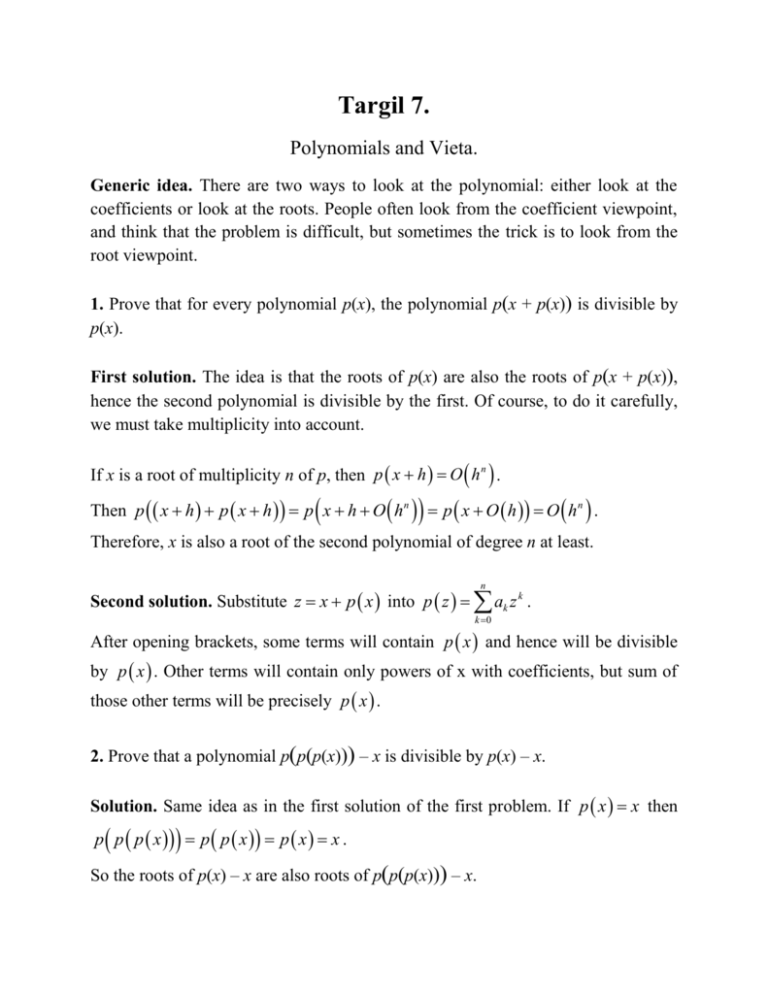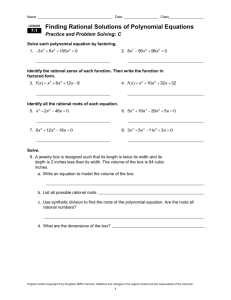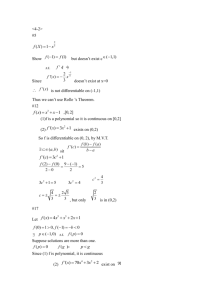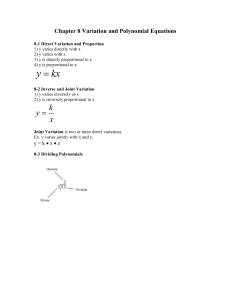Targil 7. Polynomials and Vieta. Generic idea. There are two ways to
advertisement

Targil 7. Polynomials and Vieta. Generic idea. There are two ways to look at the polynomial: either look at the coefficients or look at the roots. People often look from the coefficient viewpoint, and think that the problem is difficult, but sometimes the trick is to look from the root viewpoint. 1. Prove that for every polynomial p(x), the polynomial p(x + p(x)) is divisible by p(x). First solution. The idea is that the roots of p(x) are also the roots of p(x + p(x)), hence the second polynomial is divisible by the first. Of course, to do it carefully, we must take multiplicity into account. If x is a root of multiplicity n of p, then p x h O h n . Then p x h p x h p x h O h n p x O h O h n . Therefore, x is also a root of the second polynomial of degree n at least. n Second solution. Substitute z x p x into p z ak z k . k 0 After opening brackets, some terms will contain p x and hence will be divisible by p x . Other terms will contain only powers of x with coefficients, but sum of those other terms will be precisely p x . 2. Prove that a polynomial p(p(p(x))) – x is divisible by p(x) – x. Solution. Same idea as in the first solution of the first problem. If p x x then p p p x p p x p x x . So the roots of p(x) – x are also roots of p(p(p(x))) – x. But to make it precise we need to count multiplicities. Which can be done the same way: root x of degree n means p x h x O h n . x O h Then p p p x h p p x O h n p x O h n 2 n3 so x is a root of multiplicity at least n3 of polynomial p(p(p(x))) – x which. So the polynomial has the same roots with the same or bigger multiplicities. 3. Six real numbers satisfy: x1 < x2 < x3 y1 < y2 < y3 x1 + x2 + x3 = y1 + y2 + y3 x12 + x22 + x32 = y12 + y22 + y32 x1 > y1 Prove that x3 > y3. Consider polynomials: p x x x1 x x2 x x3 and q x x y1 x y2 x y3 . According to the conditions (and Viete) all coefficients except the free coefficient coincide. Therefore p x q x C . The derivative of p(x) has precisely two roots A < B (of degree 2, Rolle theorem). Hence p(x) is monotone increasing on , A , monotone decreasing on A, B monotone increasing on B, . Hence, if C > 0, we have x1 > y1 , x2 < y2 , x3 > y3, and if C < 0 we have x1 < y1 , x2 > y2 , x3 < y3. The last condition that was given shows it is the first case. 4. Three rational nonzero numbers a, b, c are such that a b c a c b and b c a c b a are integers. Prove that a b c . Solution. Consider the polynomial a b c 3 a b c 2 a c b x x x x x 1 . b c a b c a c b a It is a polynomial with integer coefficients and rational roots. There is a generic way to find all rational roots of a polynomial with integer coefficients: Theorem. If a polynomial an x n an1x n1 ... a2 x 2 a1x a0 has integer p coefficients and a rational root , where p and q are coprime integers, then a0 is q divisible by p, and an is divisible by q. Since there are finite number of divisors for any integer number, the search for rational roots is now reduced to only a finite number of verifications. Corollary. When the leading coefficient of the polynomial is 1 (and all other are still integer), then any rational root has to be integer. In our specific case, when both leading coefficient and free coefficient are ones, the only possible rational roots are 1. And roots ba , bc , ac are rational, which completes the solution. The theorem is well-known and might be used without proof, but we’ll still prove it. Proof of the theorem. Substitute the root and multiply the expression by qn : an p n an1 p n1q ... a2 p 2q n2 a1 pq n1 a0q n 0 All terms in the sum except a0 q n are divisible by p. Therefore a0 q n is also divisible by p. But p and q are co-prime, hence a0 is divisible by p. On the other hand all the terms in the sum except an p n are divisible by q. So an p n is also divisible by q. But p and q are co-prime, hence an is divisible by q. 5. The complex roots of polynomial p(x) of degree n are α1, α2, … , αn, the complex roots of its derivative are β1, β2, …, βn-1. (a) Prove that the mass center of α1, α2, … , αn coincides with the mass center of β1, β2, …, βn-1. (b) Prove that β1, β2, …, βn-1 are in the convex hull of α1, α2, … , αn. Solution. (a) Assume that the polynomial is cn x n cn1x n1 ... . By Vieta’s theorem, the sum of the roots is cn1 c and their mass center of the roots is n1 . cn ncn The derivative is ncn x n1 n 1 cn1 x n2 ... , sum of its roots is their mass center is cn1 which is the same as before. ncn n 1 cn1 ncn and (b) Let us start with some generic remarks about derivatives of complex function. A function C C can be considered as a function R 2 R 2 . One can consider a 2×2 matrix of partial derivatives (Jacobian). However, for a polynomial (or any a b other complex analytic function) the form of this matrix , where a bi is b a the value of complex derivative at the same point. This gives two non-trivial relations between the partial derivatives of real and imaginary part of any complex analytic function (called Cauchy-Riemann equations), and to some geometric conclusion: complex analytic function is corresponds to a conformal mapping (i. e. preserves angles) when derivative is non-zero, and to a mapping with zero partial derivatives in all direction when complex derivative is zero. We shall use only the last part. Another thing which is useful for this problem is the following simple fact: a compact convex set can be separated by a straight line from any point Z outside it. Indeed, take a point X in that set which is closest to Z. The perpendicular bisector to XZ is such a line (otherwise X wouldn’t be the closest to Z). It is easy to replace the word “compact” by the word “closed” in that statement, and it is also possible to generalize it to infinite dimensions (then it will be called Hahn-Banach theorem), but in our case we have a polygon anyway. So, let z be a root of p ' , which is outside the convex hull of the roots of polynomial p. The partial derivatives of p at z in all directions are zeroes. The partial derivatives of |p| in all directions are also zeroes at point z. n The polynomial can be written as a product over roots: p x a x xk . k 1 n Therefore p x a x xk . Partial derivative in some direction of Euclidean k 1 distance x xk is positive, if scalar product of that vector with a vector from xk to x is positive. If we consider point z, there’s a line separating z from all xk. A normal vector v to that line, pointing to the z half-plane, will have positive scalar products with all vectors pointing from xk to z. Hence the partial derivative in direction v at n point z of p z a z xk is strictly positive. This contradicts our former k 1 conclusion (that all partial derivatives there are zeros).







